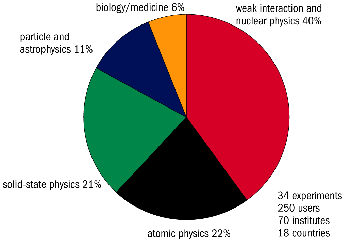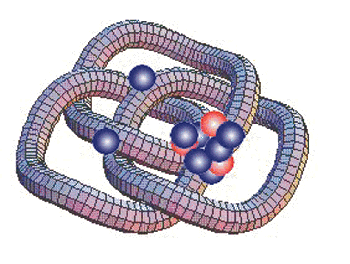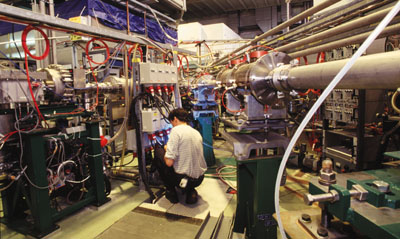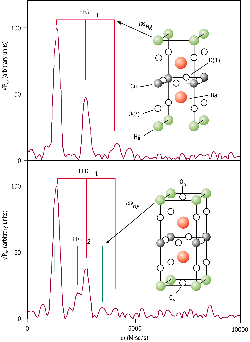Radioactive ion beams provide access to a variety of research, from basic nuclear physics to the life sciences. Thomas Nilsson looks at the varied radioactive ion beam research programme of CERN’s veteran, but constantly evolving, ISOLDE facility.

CERN’s isotope factory, ISOLDE, has a history stretching back over 30 years. ISOLDE’s unique ability to produce some 600 isotopes of 70 elements has ensured it a place at the forefront of low-energy radioactive-beam research and permits a programme that ranges from basic nuclear structure and weak interaction studies to applied fields like solid-state physics and the life sciences. ISOLDE owes its longevity to the ISOLDE team’s ability to develop new and more intense isotope beams and to the resourcefulness of the scientists, who design ever-more ingenious experiments for the facility.
The heart of ISOLDE is a target station where a 1 or 1.4 GeV proton beam from CERN’s booster accelerator strikes a target to produce a range of isotopes. Those of interest are then extracted, ionized and separated before being delivered to experiments. ISOLDE has always been able to produce extremely pure radioactive beams of a variety of species by combining a range of target materials with efficient and selective ion sources.
The Laser Ion Source
An important recent development, however, has allowed ISOLDE to improve efficiency and beam purity further. The Laser Ion Source (LIS) works by shining a combination of three laser beams into the cloud of nuclei released from the ISOLDE target. The combination acts like a key in a lock and selectively ionizes the isotopes of interest. This gives an unprecedented combination of both ionization efficiency and selectivity and has already allowed important measurements to be made on key processes that are believed to play a role in supernova nucleosynthesis.

More recently the LIS has been employed to produce isotopes of beryllium, which opens up a new range of possible experiments. Beryllium-7, for example, holds a key to the solar neutrino problem: the apparent deficit of neutrinos coming from the Sun that has been puzzling researchers for decades. One of the important reactions that gives rise to solar neutrinos is the capture of protons by beryllium-7. A precise knowledge of that isotope’s structure is important in understanding the expected flux of beryllium-7 related neutrinos from the Sun. An ISOLDE experiment has recently measured the quadrupole moment of the isotope. Furthermore, an experiment at Israel’s Weizmann Institute measures beryllium-7 proton capture using a beryllium-7 target made at ISOLDE.
Other, more esoteric, experiments use beryllium-11 and beryllium-14 to investigate a topic that has attracted much interest in recent years. In the 1980s, experiments on lithium-11 suggested that the nucleus might have a “halo” of two very loosely bound neutrons that surround a core lithium-9 nucleus. The proposed halo structure of lithium-11 has since been well established, both experimentally and theoretically, with much of the experimental work coming from ISOLDE.
Many similar neutron-rich nuclei have since been found and among them were beryllium-11 and beryllium-14. Beryllium-11, which has a single halo neutron, is the most simple halo nucleus. Its halo structure has recently been confirmed by the COLLAPS collaboration at ISOLDE, which has found that the magnetic dipole moment of beryllium-11 is consistent with a halo structure.
Berylium-14 is an altogether more complex object. Like lithium-11 it is a loosely bound three-body structure with two halo neutrons. Such nuclei have been dubbed Borromean because of a characteristic that they share with the heraldic Borromean rings symbol, which also features in mathematical knot theory. Just as a lithium-11 nucleus is a loosely bound state of three bodies, a Borromean ring system is an object composed of three intertwined rings. Whenever one ring is removed the remaining two are no longer bound to each other. The same is true of Borromean nuclei. These are three-body bound states in which any two-body subsystem would not be bound. The di-neutron is not bound, nor is lithium-9 plus a single neutron.
Producing beryllium-14 is particularly difficult because it has a half-life of only 4.3 ms, making it the shortest-lived isotope studied to date at ISOLDE. Few beryllium-14 nuclei survive long enough to escape the target, but a production rate of eight atoms per second has been achieved.
In lithium-11 a number of exotic decay modes involving the emission of tritons, deuterons, or up to three neutrons have been identified. These are associated with the halo structure, and the experimental goal of ISOLDE is to look for similar decay modes in beryllium-14. An early result shows that the probability of one-neutron emission is close to 100%. Further experiments are planned to search for other exotic decay modes.
Solid-state physics and life sciences
Radioactive nuclei are also used as powerful probes in solid-state physics (CERN Courier October 1998) and life sciences. One range of experiments studies the effect of hydrogen in semiconductors such as indium phosphide (InP), gallium arsenide (GaAs) and indium arsenide (InAs). Hydrogen can enter a semiconductor at many stages during production, causing passivation of intentionally introduced dopants by the formation of hydrogendopant complexes.

This is investigated at ISOLDE by implanting radioactive silver-117, which decays into cadmium-117. Cadmiumhydrogen pairs then form and, when the cadmium itself decays, the hydrogen is free to diffuse within the semiconductor. Information about the diffusion of hydrogen in the semiconductor can be gleaned by studying the gamma-ray distribution from the cadmium decay.
Another emerging area in which ISOLDE scientists are active is high-TC superconductors. Among the many that have been found, certain mercury-based materials achieve the highest critical temperature, of 135 K, at ambient pressure. These materials have a simple tetragonal lattice structure in which oxygen regulates the superconducting charge carriers and increases or decreases TC. ISOLDE researchers are able to extract information about the oxygen’s behaviour and concentration at the mercury lattice planes by measuring the electric field gradient that is caused by the charge distribution around implanted radioactive mercury probe nuclei.
In the life sciences, ISOLDE’s radionuclides are very suitable for use in biomedical research. One of the most interesting applications is cancer research. Certain modern techniques of systemic cancer therapy make use of “intelligent” molecules, which seek out specific binding sites in cancer cells with high selectivity. Such molecules can be used as vehicles to carry radioactive isotopes, produced at facilities such as ISOLDE, into the cancer tissue where they kill cancer cells. ISOLDE research into such novel forms of cancer therapy is guided by the Division of Nuclear Medicine at Geneva’s University Hospital.
Mass measurements
The mass of a nucleus is a fundamental quantity with importance in fields as diverse as nuclear physics and cosmology. This is particularly true of short-lived radioactive isotopes, for which ISOLDE has a long-standing tradition in high-precision mass measurements. The ISOLTRAP experiment, which is a combination of a recently added radiofrequency quadrupole cooler and two consecutive Penning traps, has mapped the nuclear mass surface over a sizable part of the nuclear chart with a resolution of 10-7.
ISOLTRAP will continue to be one of the major ISOLDE experiments for many years. However, it is limited to nuclei with half-lives of around 1 s and longer. This limitation is overcome in a complementary mass-measuring experiment called MISTRAL (CERN Courier September 1997), which has measured the masses of 15 radioactive isotopes, 3 of which have half-lives of less than 50 ms, with a mass resolution better than 10-5. These results are now providing valuable input to nuclear structure calculations.
Search for physics beyond the Standard Model
Radioactive nuclei are not only highly interesting systems in their own right but can also yield information regarding fundamental interactions, which is complementary to the results from high-energy physics. Nuclear beta decay, for example, is mediated by the exchange of W bosons having only certain (vector and axial-vector) couplings according to the Standard Model. However, theories beyond the Standard Model predict other weak couplings in nuclear beta decay. These could manifest themselves in electronneutrino correlations in super-allowed beta decays. The detection of the neutrino in the decay is practically impossible, so this correlation must be deduced from the velocity of the recoiling daughter nucleus.

This is an extremely delicate task because the velocities involved are very small and the movement of the daughter nucleus is affected by the surrounding material. In an experiment at ISOLDE, this last problem was partly circumvented by studying the decay of argon-32, which decays by beta-delayed proton emission. The energy peaks of the protons are then Doppler-broadened by the movement of the emitting daughter nucleus. Subsequently this broadening can be traced back to the electronneutrino correlation. The results were consistent with the Standard Model and have led to improved constraints on the scalar weak interaction.
Another quest for new physics is the search for right-handed currents in nuclear beta decay. This can be studied via the polarization of positrons that are emitted from a polarized radioactive source. Such an experiment has recently started taking data at ISOLDE.
REX-ISOLDE
In the past, ISOLDE has concentrated its efforts on the study of radioactive nuclei at very low energies less than 60 keV. The new REXISOLDE experiment is set to change this dramatically. A novel scheme for beam cooling, bunching, charge state breeding and subsequent acceleration will launch almost any isotope that is currently produced at ISOLDE into the 0.82.2 MeV per nucleon energy range. This opens up a completely new field of experiments with radioactive ion beams.
To convert a singly charged beam from the ISOLDE separator into a multiple-charged pulsed beam, which is suitable for acceleration, without losing too large a fraction of the painfully created radioactive nuclei, requires advanced techniques. Initially the ISOLDE beam is trapped, cooled and bunched in a linear Penning trap. The bunched beam is then transported to an electron beam ion source, where it is confined while being bombarded with a strong electron current in order to reach higher charge states. The ions are then re-accelerated and separated according to charge state before reaching a Linac. The overall efficiency is estimated to be 10%.
The REXISOLDE experiment aims to find out whether or not the magic numbers 20 and 28 are conserved when going to very neutron-rich nuclei. Other experiments have hinted at a weakening of the nuclear shell structure in the region of magnesium-32 (the most commonly occurring isotope is magnesium-24) and below calcium-48 (calcium-40 is the most commonly occurring isotope) with deduced sizable deformations.
The main detector system to be used for these experiments is the state-of-the-art gamma-detector array, MINIBALL, which is being constructed by a large European collaboration. Once REXISOLDE is ready, however, a large number of other experiments are also expected to make use of this powerful new instrument. Two more experiments are already approved. Both are concerned with investigating the unbound subsystems of halo nuclei like lithium-10. In the near future, other experiments that will take place concern the structure of unstable, medium-heavy (mass numbers between 50 and 100) nuclei with approximately the same number of neutrons and protons, proton radioactivity and nuclear astrophysics. The installation of the REX post-accelerator is well under way and the first post-accelerated radioactive beams are expected during 2000.
Outlook
With a well established physics programme, ISOLDE would be able to continue operation for many years to come with the current and foreseeable techniques, in particular with the REXISOLDE, including a possible energy upgrade to above 5 MeV per nucleon. However, the path towards new physics often relies on the availability of new or more intense radioactive beams, so the proton beam intensity delivered by the booster will become a limiting factor.
A number of new or upgraded facilities are currently being planned, built or commissioned worldwide. These will complement ISOLDE but they will still be first-generation facilities. There is considerable interest around the world in building a second-generation radioactive ion beam facility. In Europe this is spearheaded by the Nuclear Physics European Collaboration Committee (CERN Courier May p23) and in the US by the Department of Energy. Both have independently recommended the construction of a second-generation facility based on the ISOLDE principle, where radioactive beam intensities around 100 times higher than at the current facilities can be produced.
ISOLDE is well placed for further advances before such a facility comes along. ISOLDE currently uses about half of the number of protons delivered by the booster, but its target could easily withstand beam intensities more than an order of magnitude higher. ISOLDE physicists are currently studying the possibility of using a 2 GeV high-current proton Linac, which might form part of CERN’s LHC injector complex, to upgrade the facility further in years to come. A small part of the then available protons would be used by the driver beam, which would propel the ISOLDE to new scientific heights.







